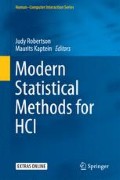Abstract
Latent class analysis (LCA) and latent profile analysis (LPA) are techniques that aim to recover hidden groups from observed data. They are similar to clustering techniques but more flexible because they are based on an explicit model of the data, and allow you to account for the fact that the recovered groups are uncertain. LCA and LPA are useful when you want to reduce a large number of continuous (LPA) or categorical (LCA) variables to a few subgroups. They can also help experimenters in situations where the treatment effect is different for different people, but we do not know which people. This chapter explains how LPA and LCA work, what assumptions are behind the techniques, and how you can use R to apply them.
Access this chapter
Tax calculation will be finalised at checkout
Purchases are for personal use only
Notes
- 1.
Confusingly, sometimes latent class analysis is used as a broader term for mixture models.
- 2.
This is not true, but the rest of the chapter is.
- 3.
Apparently, Ms. Parveen is 213.4 cm and Mr. Dangi is 48.3 cm.
- 4.
As can be gleaned from the figures, by “normal curve” I mean the probability density function.
- 5.
We also need to know the proportion of men/women \(\pi _1^{X}\) but I will ignore that for the moment.
References
Bakk Z, Tekle FB, Vermunt JK (2013) Estimating the association between latent class membership and external variables using bias-adjusted three-step approaches. Sociol Methodol 43(1):272–311
Collins LM, Lanza ST (2013) Latent class and latent transition analysis: with applications in the social, behavioral, and health sciences, vol 718. Wiley, New York
Fraley C, Raftery AE (1999) Mclust: software for model-based cluster analysis. J Classif 16(2):297–306
Gruen B, Leisch F, Sarkar D (2013) flexmix: Flexible mixture modeling. http://CRAN.R-project.org/package=flexmix. R package version, pp 2–3
Hagenaars JA, McCutcheon AL (2002) Applied latent class analysis. Cambridge University Press, Cambridge
Hussain Z, Williams GA, Griffiths MD (2015) An exploratory study of the association between online gaming addiction and enjoyment motivations for playing massively multiplayer online role-playing games. Comput Hum Behav 50:221–230
Imai K (2013) Experiment: R package for designing and analyzing randomized experiments. R package version 1.1-1
Linzer DA, Lewis JB (2011) poLCA: an R package for polytomous variable latent class analysis. J Stat Softw 42(10):1–29
McLachlan, G. and Peel, D. (2004). Finite mixture models. John Wiley & Sons, New York
Muthén LK, Muthén B (2007) Mplus user’s guide. Muthén & Muthén, Los Angeles
Nagygyörgy K, Urbán R, Farkas J, Griffiths MD, Zilahy D, Kökönyei G, Mervó B, Reindl A, Ágoston C, Kertész A et al (2013) Typology and sociodemographic characteristics of massively multiplayer online game players. Int J Hum-Comput Interaction 29(3):192–200
R Core Team (2012) R: a language and environment for statistical computing. R Foundation for Statistical Computing, Vienna, Austria. ISBN 3-900051-07-0
Skrondal A, Rabe-Hesketh S (2004) Generalized latent variable modeling: multilevel, longitudinal, and structural equation models. Interdisciplinary statistics series. Chapman & Hall/CRC, Boca Raton
Vermunt JK, Magidson J (2004) Latent class analysis. The sage encyclopedia of social sciences research methods, pp 549–553
Vermunt J, Magidson J (2013a) LG-Syntax user’s guide: manual for Latent GOLD 5.0 Syntax Module. Statistical Innovations Inc., Belmont
Vermunt JK, Magidson J (2013b) Technical guide for Latent GOLD 5.0: basic, advanced, and syntax. Statistical Innovations Inc., Belmont
Yang M-H, Ahuja N (2001) Face detection and gesture recognition for human-computer interaction. Springer Science & Business Media
Author information
Authors and Affiliations
Corresponding author
Editor information
Editors and Affiliations
Rights and permissions
Copyright information
© 2016 Springer International Publishing Switzerland
About this chapter
Cite this chapter
Oberski, D. (2016). Mixture Models: Latent Profile and Latent Class Analysis. In: Robertson, J., Kaptein, M. (eds) Modern Statistical Methods for HCI. Human–Computer Interaction Series. Springer, Cham. https://doi.org/10.1007/978-3-319-26633-6_12
Download citation
DOI: https://doi.org/10.1007/978-3-319-26633-6_12
Published:
Publisher Name: Springer, Cham
Print ISBN: 978-3-319-26631-2
Online ISBN: 978-3-319-26633-6
eBook Packages: Computer ScienceComputer Science (R0)

